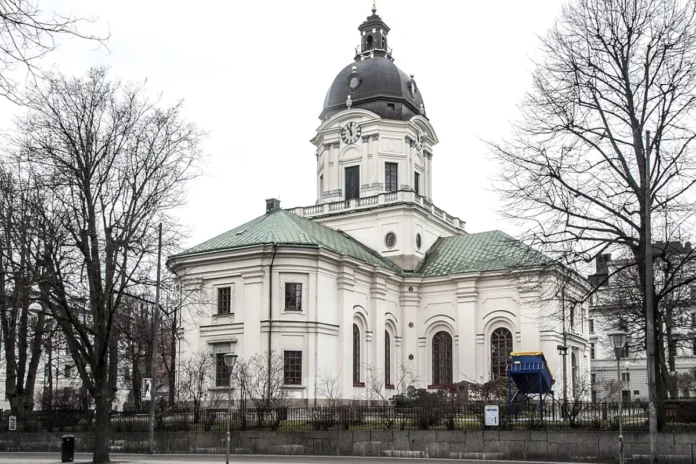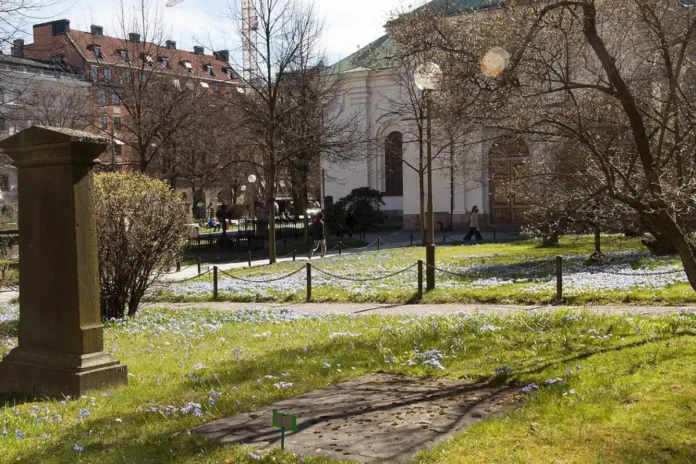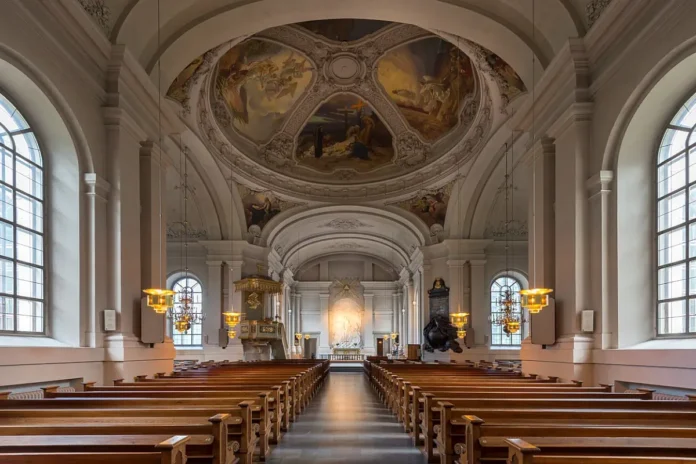Located in the Adolf Fredrik parish of Stockholm’s diocese, Adolf Fredrik Church stands at the bustling intersection of Sveavägen, Adolf Fredriks kyrkogata, Holländargatan, and Kammakargatan. This 18th-century landmark, designed by architect Carl Fredrik Adelcrantz, can host up to 800 visitors and blends Gustavian neoclassicism with rococo flair.
A Historical Treasure and Architectural Wonder
The church, commissioned by King Adolf Fredrik, was inaugurated on November 27, 1774. The ceremony was attended by his sons, King Gustav III and Duke Karl, who would later become King Karl XIII. Its Greek cross layout, white plaster walls, copper roofs, and black-painted dome create a striking exterior, while the interior features Johan Tobias Sergel’s altarpiece depicting Jesus’ Resurrection and the Cartesius Monument, symbolizing the triumph of truth over falsehood.
Gustavian architecture with Rococo elements
Adelcrantz’s design epitomizes Gustavian neoclassicism—a Swedish interpretation of Neoclassicism marked by symmetry, restrained ornamentation, and geometric simplicity. Furthermore, the 1893–1895 interior redesign added intricate reliefs and stucco, enhancing its serene atmosphere.
Exterior grandeur and serene interior
The church’s exterior captivates with gold-accented reliefs, a 116-meter dome, and copper roofs. Inside, the predominantly white decor fosters a tranquil ambiance, making it a haven for art enthusiasts.
A revered burial ground
The churchyard is where Prime Minister Olof Palme, sculptor Johan Tobias Sergel, and philosopher René Descartes are buried. Descartes was buried there from 1650 to 1666 before being reburied in France. Additionally, other notable figures include Hjalmar Branting (Sweden’s first socialist PM) and actor Thor Modéen.
Other attractions near the Adolf Fredrik Church
- Stockholm Public Library (Stockholms Stadsbibliotek): Architect Gunnar Asplund created this iconic library, showcasing its stunning cylindrical design and extensive collection of books.
- Observatory Hill (Observatorielunden): The park offers stunning panoramic views of the city and showcases the historic Stockholm Observatory.
- Odenplan: A lively square that serves as a key transportation hub and features various shops, cafes, and restaurants.
- Hötorget Market: A market where visitors can find fresh produce, flowers, and local delicacies.
- Strindberg Museum (Strindbergsmuseet): Dedicated to the famous Swedish author August Strindberg, this museum provides insights into his life and works.
- Kulturhuset Stadsteatern: A cultural center and theater complex offering a wide range of performances, exhibitions, and events.
- Vasaparken: A popular park featuring green spaces, playgrounds, and sports facilities, perfect for a leisurely stroll or picnic.
- Drottninggatan: One of Stockholm’s main shopping streets, filled with stores, cafes, and restaurants.
- Stockholm Concert Hall (Konserthuset): This venue, home to the Royal Stockholm Philharmonic Orchestra, is known for its beautiful architecture and musical performances.
- Rådmansgatan Metro Station offers easy access to various parts of the city, making it a convenient stop for travelers.
These attractions offer a mix of cultural, historical, and recreational experiences, making them perfect companions to a visit to Adolf Fredrik Church.










